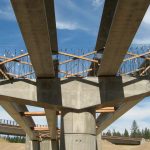This project will investigate the measures that WSDOT can take to attenuate noise on SR 520 that is created by the bridge’s expansion joints. The researchers will inspect the modular expansion joints and surrounding structures in the field. They will review the literature, and they will evaluate commercially available expansion joint modification technologies, as well as available noise mitigation treatments. After proposing designs to decrease noise levels, the researchers will conduct cost and durability analyses and accelerated wear and durability testing. The goal will be to reduce noise from expansion joints on SR 520 in the most safe and cost-effective manner.
Principal Investigator: Per Reinhall, Mechanical Engineering, UW
Sponsor: WSDOT
WSDOT Technical Monitor: Mark Gaines
WSDOT Project Manager: Rhonda Brooks
Scheduled completion: February 2019


